Insects .
Insects abound in fresh waters: they dominate the communities of streams
and small rivers, and are responsible for much of the flow of energy in
these ecosystems (see Section 7) serving as a major for a range of fishes,
amphibians and birds. Some 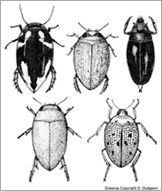 families
of insects are aquatic throughout their lives, while for others the main
aquatic stage is the larva (the opposite – terrestrial larvae and aquatic
adults – is extremely rare). The adults usually have wings, and these
remain functional in most species (of dytiscid Coleoptera, for example)
that have aquatic adults. Colonization of new habitats, or recolonization
of those that have dried out, has almost certainly been the evolutionary
advantage that has favoured the retention of functional wings in adult
aquatic insects. It may also account for their success in fresh waters
and other habitats.
families
of insects are aquatic throughout their lives, while for others the main
aquatic stage is the larva (the opposite – terrestrial larvae and aquatic
adults – is extremely rare). The adults usually have wings, and these
remain functional in most species (of dytiscid Coleoptera, for example)
that have aquatic adults. Colonization of new habitats, or recolonization
of those that have dried out, has almost certainly been the evolutionary
advantage that has favoured the retention of functional wings in adult
aquatic insects. It may also account for their success in fresh waters
and other habitats.
All insects have three main body parts: the head, thorax, and abdomen.
Three pairs of jointed legs and two pairs of wings are located on the
thorax, while the abdomen may have lateral gills or filaments, prolegs
('false legs' that are short and not jointed), and/or anal gills and 'tails'
or cerci. Some insects develop gradually through the life cycle with the
juvenile coming to resemble the adult form more and more as it nears maximum
size. These are more ancient orders of insects. They consist of fewer
species than orders that have distinct, and very different, larval and
adult stages separated by a pupal stage when the insect metamorphosis
takes place.
Insect adaptations: aquatic respiration
Respiration under water is a problem for any animal which, like an insect,
has evolved from terrestrial ancestors. On land, respiration is accomplished
by way of a network of air-filled tubes or trachea through which gaseous
oxygen is distributed to various parts of the body. A series of openings
or spiracles (which can be closed by 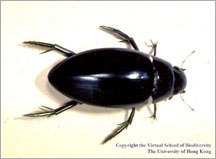 muscles)
connect the tracheal system to the surrounding air. Insects have evolved
a number of solutions to the problem of aquatic respiration; they fall
into two groups. Some species come to the water surface and have at least
one pair of functional spiracles with which they breathe atmospheric oxygen.
Some adult Coleoptera and Heteroptera carry a bubble underwater that is
used as an air store.
muscles)
connect the tracheal system to the surrounding air. Insects have evolved
a number of solutions to the problem of aquatic respiration; they fall
into two groups. Some species come to the water surface and have at least
one pair of functional spiracles with which they breathe atmospheric oxygen.
Some adult Coleoptera and Heteroptera carry a bubble underwater that is
used as an air store.
In the second group of species, the spiracular system is closed and oxygen
is obtained through the body surface. Most s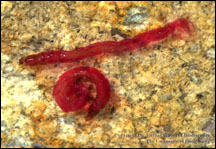 pecies
carrying out respiration in this way require well-aerated water, although
some Diptera (Chironomidae) can survive oxygen-poor conditions because
their 'blood' contains haemoglobin. Many insects have thin-walled, often
leaf-like projections from the body that contain tracheae. Others possess
filamentous bunches or tuft-like outgrowths of the tracheal system. These
structures are variously termed gills (in Ephemeroptera , Plecoptera,
Trichoptera and Lepidoptera), filaments (in Megaloptera) or lamellae (in
Zygoptera). All seem to have a respiratory function. The ability to ventilate
the gills varies in different groups: some Ephemeroptera beat the gills
rhythmically; most Trichoptera undulate the abdomen drawing water over
the gills. However, many insects cannot ventilate their gills effectively
and so are confined to running water where the current ensures a continuous
supply of oxygen. Insects with functional spiracles breathe atmospheric
oxygen and can occupy a wide range of habitats; they dominate in floodplain
areas or places where flow and dissolved oxygen may be limited.
pecies
carrying out respiration in this way require well-aerated water, although
some Diptera (Chironomidae) can survive oxygen-poor conditions because
their 'blood' contains haemoglobin. Many insects have thin-walled, often
leaf-like projections from the body that contain tracheae. Others possess
filamentous bunches or tuft-like outgrowths of the tracheal system. These
structures are variously termed gills (in Ephemeroptera , Plecoptera,
Trichoptera and Lepidoptera), filaments (in Megaloptera) or lamellae (in
Zygoptera). All seem to have a respiratory function. The ability to ventilate
the gills varies in different groups: some Ephemeroptera beat the gills
rhythmically; most Trichoptera undulate the abdomen drawing water over
the gills. However, many insects cannot ventilate their gills effectively
and so are confined to running water where the current ensures a continuous
supply of oxygen. Insects with functional spiracles breathe atmospheric
oxygen and can occupy a wide range of habitats; they dominate in floodplain
areas or places where flow and dissolved oxygen may be limited.
Insect adaptations: dealing with current
Many insects that live on the bottom of streams and rivers (i.e., they
are benthic species) have flattened bodies, enabling them to 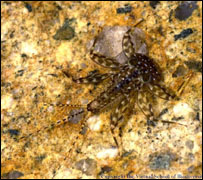 avoid
high current speeds by living in the slow-moving boundary layer of water
that exists immediately above the streambed. While it is almost certainly
the case that flattening is an adaptation for avoiding current in some
Ephemeroptera (e.g.,: Heptageniidae), in others it may have evolved to
allow them to fit into crevices among cobbles, and this may reflect
avoid
high current speeds by living in the slow-moving boundary layer of water
that exists immediately above the streambed. While it is almost certainly
the case that flattening is an adaptation for avoiding current in some
Ephemeroptera (e.g.,: Heptageniidae), in others it may have evolved to
allow them to fit into crevices among cobbles, and this may reflect 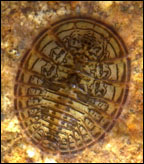 a
need for concealment from predators. Thus a flattened shape may be associated
with living on top of stones, or living among and underneath them. Streamlining
to reduce drag is less common than flattening, but is seen in many baetid
Ephemeroptera that have fish-like body shapes. Hydraulic suckers that
exert negative pressure are rare in stream insects but have evolved in
the dipteran family Belpharoceridae that is specialised for life in mountain
torrents. However, many species with flattened bodies that live in fast
current torrents have bodies modified to appear sucker-like. The body
margins make close contact with the rocks and, as well as increasing frictional
resistance to flow, this will prevent the current flowing under the insect
and lifting it up. Psephenidae (Coleoptera) larvae that have flat, coin-like
bodies are an example of this adaptation.
a
need for concealment from predators. Thus a flattened shape may be associated
with living on top of stones, or living among and underneath them. Streamlining
to reduce drag is less common than flattening, but is seen in many baetid
Ephemeroptera that have fish-like body shapes. Hydraulic suckers that
exert negative pressure are rare in stream insects but have evolved in
the dipteran family Belpharoceridae that is specialised for life in mountain
torrents. However, many species with flattened bodies that live in fast
current torrents have bodies modified to appear sucker-like. The body
margins make close contact with the rocks and, as well as increasing frictional
resistance to flow, this will prevent the current flowing under the insect
and lifting it up. Psephenidae (Coleoptera) larvae that have flat, coin-like
bodies are an example of this adaptation.
In many insects, a flattened shape is accompanied by well-developed strong
claws on the tips of the legs to provide a good grip on the substratum.
Claws and/or hooks are seen in other species also, and occur on both the
thoracic legs and the abdominal prolegs of Trichoptera, Megaloptera and
Gryrinidae (Coleoptera). Ephemeroptera larvae that live in fast current
tend to have shorter, thicker and more toothed claws on the legs, when
compared to 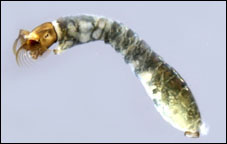 the
thin delicate claws of those dwelling in standing water. Simuliidae (Diptera)
larvae spin a mat of silk that is stuck to the rock and then attach themselves
to it by a circle of hooks on the tip of the abdomen. Like some Diptera,
Trichoptera produce silk using the salivary glands. This is used as a
material for building portable cases of sand, small stones, and leaf or
twig fragments. Stone cases can serve as ballast, and are common (or contain
larger stones) in species found in flowing water. Other Trichoptera (e.g.,
Hydropsychidae) build fixed shelters that are associated with a silk capture
net used to filter the passing water. This habit of building shelters
or tubes, as occurs also in Chironomidae (Diptera), protects the occupants
from exposure to the force of the current (and enemies). Giller and Malmqvist
(1998: Chapter 5) give a more detailed account of these and other adaptations
to life in running water.
the
thin delicate claws of those dwelling in standing water. Simuliidae (Diptera)
larvae spin a mat of silk that is stuck to the rock and then attach themselves
to it by a circle of hooks on the tip of the abdomen. Like some Diptera,
Trichoptera produce silk using the salivary glands. This is used as a
material for building portable cases of sand, small stones, and leaf or
twig fragments. Stone cases can serve as ballast, and are common (or contain
larger stones) in species found in flowing water. Other Trichoptera (e.g.,
Hydropsychidae) build fixed shelters that are associated with a silk capture
net used to filter the passing water. This habit of building shelters
or tubes, as occurs also in Chironomidae (Diptera), protects the occupants
from exposure to the force of the current (and enemies). Giller and Malmqvist
(1998: Chapter 5) give a more detailed account of these and other adaptations
to life in running water.
Ephemeroptera
 The
order Ephemeroptera (mayflies) comprises over 2,000 species worldwide.
They occur in a variety of freshwater habitats but are most diverse in
small rivers; very few species live in standing water. All Ephemeroptera
have aquatic larvae and short-lived terrestrial adults that do not feed.
Although the adults are rather uniform in structure, larvae exhibit a
variety of morphologies: the body of active swimmers is streamlined, while
species sprawling on or clinging to rocks are flattened; many burrowing
Ephemeroptera have cylindrical bodies with tusks on the head and broad
forelimbs for digging. Respiration is by leaf-like abdominal gills or
gill tufts, and Ephemeroptera larvae can be recognised by their possession
of abdominal gills and two or three 'tails' (i.e., cerci or caudal filaments)
at the end of the abdomen. Most Ephemeroptera feed on periphytic algae
(or biofilm) and fine organic particles (although a tiny minority are
filter feeders or predators). For this reason, and because they are generally
abundant, Ephemeroptera play an important role in freshwater food chains.
The
order Ephemeroptera (mayflies) comprises over 2,000 species worldwide.
They occur in a variety of freshwater habitats but are most diverse in
small rivers; very few species live in standing water. All Ephemeroptera
have aquatic larvae and short-lived terrestrial adults that do not feed.
Although the adults are rather uniform in structure, larvae exhibit a
variety of morphologies: the body of active swimmers is streamlined, while
species sprawling on or clinging to rocks are flattened; many burrowing
Ephemeroptera have cylindrical bodies with tusks on the head and broad
forelimbs for digging. Respiration is by leaf-like abdominal gills or
gill tufts, and Ephemeroptera larvae can be recognised by their possession
of abdominal gills and two or three 'tails' (i.e., cerci or caudal filaments)
at the end of the abdomen. Most Ephemeroptera feed on periphytic algae
(or biofilm) and fine organic particles (although a tiny minority are
filter feeders or predators). For this reason, and because they are generally
abundant, Ephemeroptera play an important role in freshwater food chains.
The most species-rich families of Ephemeroptera in stony streams and small
rivers are Baetidae, Heptageniidae and Leptophlebiidae; Ephemerellidae
and, in areas of quiet water, Caenidae are of secondary importance. In
larger rivers, burrowing or wood-boring Ephemeroptera in the Ephemeridae,
Polymitarcyidae and Potamanthidae occur, although a few species of caenids
and specialised baetids (mainly Cloeon) may be present.
Odonata
Adult stages of the Odonata (collectively termed dragonflies) are conspicuous
insects that are often large and colourful, although the larvae are less
familiar. The order consists of about 5,500 species and is most diverse
in tropical latitudes. It is made up of two suborders: the Zygoptera (damselflies)
and Anisoptera (dragonflies). Adult Zygoptera are slender insects, with
fore- and hindwings that are similar in general appearance and held above
the body when perching. Their larvae have three (occasionally two) external
gills situated at the tip of the elongated abdomen, and can be in the
form of sacs, flat blades, or leaf-like structures. Adult Anisoptera –
or dragonflies – are relatively stout (and usually larger) strong-flying
insects, with fore- and hindwings that differ somewhat in shape that are
held flat when the insect perches. Their larvae have internal gills within
the rectum, and are relatively squat-bodied with a short, broad abdomen.
Water projected from the anus by contraction of the rectal muscles can
cause dragonfly larvae to shoot through the water as though they were
jet-propelled.
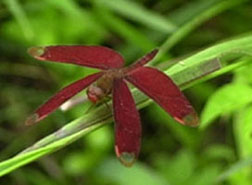 |
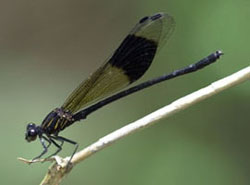 |
All odonate larvae are predators,
and prey are captured with the aid of a highly modified and elongate,
grasping labium or 'lower lip'. It can be projected forward rapidly to
grasp prey whereupon it is retracted bringing the prey within reach of
the jaws. When not in use, the labium is folded flat beneath the head.
The adults are predators also. 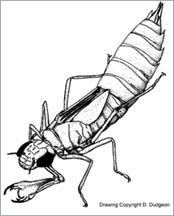 Larvae
will eat almost any type of aquatic prey, whether vertebrate or invertebrate,
the only limitation being what they are able to catch. Cannibalism is
common.
Larvae
will eat almost any type of aquatic prey, whether vertebrate or invertebrate,
the only limitation being what they are able to catch. Cannibalism is
common.
Many families of Zygoptera are riverine specialists, and forested hillstreams
are especially rich in species. Chlorocyphidae, Calopterygidae and Euphaeidae
are typical of upland rivers. Coenagrionidae are associated with both
standing and flowing water and, like the Platycnemidae, are characteristic
of lowland rivers and floodplains where the larvae are often found among
aquatic macrophytes. The majority of Anisoptera species occurs in slow-flowing
or standing water, but the diverse Gomphidae includes a large number of
species confined to rivers where larvae may burrow in sand and mud waiting
to ambush prey. Macromiidae are also mainly confined to running water.
A few genera of Aeshnidae and Libellulidae are restricted to streams,
but these two families are more diverse in ponds, marshes and floodplain
pools. Odonate adults are often colourful, and males may guard territories
that they patrol constantly. Species such as Pantala flavescens (Libellulidae)
have migratory adults, that breed in temporary pools.
Plecoptera
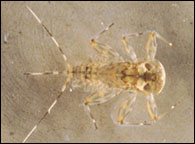 Plecoptera
(stoneflies) are diverse in temperate latitudes, but most tropical species
are confined to the upper, stony reaches of rivers where the temperature
is relatively cool and constant, and oxygen is readily available. Larvae
have gill tufts on the thorax and a pair of 'tails' (called cerci) at
the end of the abdomen. Adults are poor fliers and are seldom encountered.
Although there are around 1,800 species in 15 families worldwide, only
three families are of importance in Asian rivers. The Perlidae (mainly
subfamily Neoperlinae) includes the majority of species; all are predators
on other insects and some may be quite large. The Nemouridae are small
Plecoptera that eat decaying plant material, and the Leuctridae contains
a few species that burrow into stream sediments where they feed on fine
organic matter.
Plecoptera
(stoneflies) are diverse in temperate latitudes, but most tropical species
are confined to the upper, stony reaches of rivers where the temperature
is relatively cool and constant, and oxygen is readily available. Larvae
have gill tufts on the thorax and a pair of 'tails' (called cerci) at
the end of the abdomen. Adults are poor fliers and are seldom encountered.
Although there are around 1,800 species in 15 families worldwide, only
three families are of importance in Asian rivers. The Perlidae (mainly
subfamily Neoperlinae) includes the majority of species; all are predators
on other insects and some may be quite large. The Nemouridae are small
Plecoptera that eat decaying plant material, and the Leuctridae contains
a few species that burrow into stream sediments where they feed on fine
organic matter.
Heteroptera
The Heteroptera (aquatic bugs) includes insects that utilise aquatic habitats
as larvae and adults. The fall into two major ecological groups: one is
semiaquatic because they live on the surface of the water; they belong
to the suborder Gerromorpha and are carnivores that forage for insects
that have 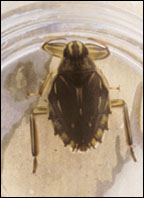 drowned
or become trapped in the surface film. The second group – suborder
Nepomorpha – is a mixture of families that live under water; many
are free swimming. This means that, in general, they are confined to pools
or river reaches where the current is not too swift to prevent swimming,
although some Naucoridae (Aphelocheirus) live on the bed of fast-flowing
stony streams.
drowned
or become trapped in the surface film. The second group – suborder
Nepomorpha – is a mixture of families that live under water; many
are free swimming. This means that, in general, they are confined to pools
or river reaches where the current is not too swift to prevent swimming,
although some Naucoridae (Aphelocheirus) live on the bed of fast-flowing
stony streams.
The combined total number of aquatic and semiaquatic species of Heteroptera
approaches 4,000. Tropical Asia is particularly rich in species, and Gerromorpha
are found in almost all water bodies – even on the surface of swift streams
and around waterfalls. Heteroptera are characterised by forewings that
are hard and leathery – at least in the anterior portion. In addition,
they all have syringe-like mouthparts. In the majority of species, feeding
involves the injection of enzymes (and sometimes venom) into prey followed
by digestion of tissue that is sucked out and swallowed. The forelegs
of most families are raptorial; i.e., modified for grasping prey. Only
one family (the Corixidae) has become modified for herbivorous feeding
with mouthparts are adapted for rasping, not sucking.
The Gerromorpha is made up of the Gerridae – the large and conspicuous
Water striders or Water skaters, which have greatly elongated second and
third pairs of legs – and the relatively tiny Veliidae. The Nepomorpha
contains a greater variety of insects, including those that live suspended
in the water column (the Notonectidae or 'Backswimmers'), crawl or swim
over the river bed (Naucoridae and Corixidae), are associated with aquatic
macrophytes (Belostomatidae and some Nepidae), or sprawl on the bottom
mud (other Nepidae). Some are large: Gigantomera (Gerridae) has
hind legs almost 100 mm long while Lethocerus (Belostomatidae),
which can reach 80 mm in length, can be cooked and eaten.